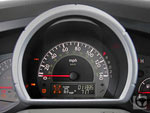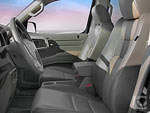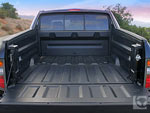 Lots of people in this world are smart, talented, adamantly set in their ways and can't be reasoned with. All of them work for Honda. More than any other, this is the company that insists on building cars one size small, two cylinders short, and front-wheel-drive whenever possible, just to name some examples. The combined forces of consumer cries, media slams, and withering sales gets the occasional concession - we got an all-wheel-drive Acura RL last year - but the rest of the time, Honda will be Honda or die trying.
Lots of people in this world are smart, talented, adamantly set in their ways and can't be reasoned with. All of them work for Honda. More than any other, this is the company that insists on building cars one size small, two cylinders short, and front-wheel-drive whenever possible, just to name some examples. The combined forces of consumer cries, media slams, and withering sales gets the occasional concession - we got an all-wheel-drive Acura RL last year - but the rest of the time, Honda will be Honda or die trying.Can you blame them? Whether because of or in spite of these methods, the products are doing just fine. Accords were outselling any other nameplate long before they grew up and got V6s while the Pilot is proving to be the spot-on approach to SUVs. Will this work at the next level? Honda's taking a whack at pickup trucks now, the segment where body-on-frame construction, heavy-duty axles, rear and 4-wheel-drive, and multiple bodies are mandatory to make a passing grade. Honda decided to skip all of the above.
Insightful, ignorant, brave, suicidal - one prediction's as good as another. The only certainty is that a headstrong car company is charging into a segment contrary to everything it stands for, and the results promise to be interesting.
Road Test

The ace up the Ridgeline's sleeve is that it will probably win over anyone who drives his rattly old truck to the dealership for a quick spin around the block. Honda engineers played with the car-like platform of its Pilot SUV to create this pickup (though not without petrifying it with steel reinforcements and seven crossmembers), and the differences hit you right away.
It may stand a few flights of stairs below the S2000 in the "sport" department, but no truck feels more at one with you than the Ridgeline. The reasons start with the literal: this is the only truck with all-of-a-piece unibody construction instead of a separate body-on-frame, making for a lighter and tighter structure. Honda claims 2.5 times more stiffness than the best competing truck. It continues with the accurate, natural, light steering that has you darting around town like you were in a sedan. Aside from a hint of truck wind noise and the usual dose of Honda road noise, it sounds like one too. In fact, have your neighbor step into a Ridgeline while blindfolded and drive it. He might just think you gave his Accord a lift job.
What really keeps the Ridgeline down to Earth is the energetic 3.5-liter V6 that kicks out 247 horsepower through the front wheels (and the rears when necessary) while humming a tune any Acura owner would approve of. Honda's 0-60 claim of 9.5 seconds has turned out to be modest compared to the 7.9 magazines have achieved. It also managed a best-in-class 18 MPG with us in mostly freeway driving, partly thanks to a really tall 0.53:1 fifth gear ratio, and its ULEV emissions keep both the Earth and the conscience clean. The Ridgeline's competitors have pretty nice cammer V6s too, but all of them go about their business with an unmistakable working-class roar that reminds you you're driving a truck.
Honda would rather you forget. There isn't a whole lot of body lean, the tires grip decently, and understeer doesn't happen easily. Having measurements similar to its mid-size truck peers means the Ridgeline is a handful to deal with in the city (its 122-inch wheelbase and 207-inch length extend far beyond a Pilot's), but it's manageable. You will find fewer bumps on your freeway cruise since there's no jumpy leaf-sprung live rear axle suspension looking for them; taking its place is a suspension with multiple links (plus a rarely found stabilizer bar) that can better compensate. On the debit side, the Ridgeline's also the only truck with struts instead of superior double-wishbones in the front, and the ride still gets a little jerky sometimes, but at least it's car jerky, right?
Of course, not all is perfect. The transmission has a pronounced bias for downshifts, which take place a tad too often and in unwanted places like parking lots. It seems to have a touchy throttle sometimes, though that's partly because the transmission's sometimes in a lower gear than expected. The brakes also seemed that way at first, though always strong and firm.
And there is the question of trade-offs. Note that the softer construction method, front-wheel-drive car basis, and 245 pounds-feet of torque engine keep towing capacity capped at 5,000 pounds - good, but 23% below the 6,500 possible in the Dakota, Tacoma, or Frontier. The Ridgeline's all-wheel-drive system lacks a low-range gear or locking differential for serious rough-riding, and that multilink rear suspension probably couldn't handle the abuse anyway. With 8.2 inches of ground clearance, the Ridgeline's a bit of a lowrider, too - better for on-road handling than off. There is the "VTM-4 LOCK" button on the dash that sends 70% of the torque to the rear wheels if you ever get stuck (for use up to 18 MPH with the transmission in the 1, 2, or R positions), but that's only for emergencies. To its credit, though, only the Ridgeline has full-time all-wheel-drive that can be left engaged all the time.
Look, here's the lowdown. You know all those qualities that get lost when going from car to truck? The Ridgeline takes half of them back.
Inside & Out

There's more to the Ridgeline's common crew cab body than meets the eye. If you go around to the back and open the tailgate - either by flipping it down normally or opening it side to side (innovation #1) - you'll find a "sheet molded composite" bed that's resistant to dents, corrosion, and slipping (innovation #2), eliminating any need for an aftermarket bedliner. After 11,000 journalist-abused miles, our test truck's bed didn't look too beaten up. Finally, this is the first documented sighting of a bed containing a trap door leading to a trunk (#3). It's a big, rectangular 8.5 cubic foot trunk at that, one with a drain plug that invites you to load it up with 50 six-packs. Given the Ridgeline's people-carrying duties and the need for lockable space, owners will likely find it immensely useful. Getting back to the bed, it's a shallow five feet long like most other crew cabs, but somewhat wider at 49.5 inches across. It's also got six tie-down cleats, it's free of wheel well bulges, the area is well-lit from all around, and the 19 inch-long lid itself can support 300 pounds.
There's more of this inside. The center console has good depth, good space, useful dividers, nice cupholders, and expands outward. The three power outlets (2 front, 1 back) are handy and the rest of the scenery is pure Honda: clear gauges, crisp buttons, and thoughtful controls everywhere. Nice leather on this RTL model, too. The steering wheel controls aren't stiff like on most Hondas, the powered rear window slides open laterally, and the windows roll down if you hold the key to the right or hold the remote fob's unlock button (except on the base RT model). Same Honda quirks, too, like the dash-mounted sunroof switch and cruise control switch next to your knee. The only things that threw me off were the column-mounted transmission lever, which kicked the wiper controls over to the left side, which had me streaking the windshield every time I tried to turn on the lights. Never seen a Japanese car with the light switch on the dash? You have now.
Deserving its own little celebration is the navigation system; it bears repeating that Honda's is probably the most user-friendly on the market, doesn't mess up the audio or climate controls one bit, and is pretty consistent from car to car. There's still the voice recognition system that lets you press a button to ask questions like "WHAT TIME IS IT!" and wait a few seconds for an answer (instead of glancing down at the clock like a lowly commoner); owners of other Hondas and Acuras will need to re-learn nothing.
More celebration for the stereo: fantastic sound quality! Radio sounds better than CDs do in some other cars. RTL models with navigation also get an auxiliary input jack above the glove compartment for portable MP3 players. And there's a decent dash of style in here - check out those stylish knobs and floor mats. Ok, the garish oversized silver door grips can go, but who knew Honda could do rugged?
The team responsible for the back seat deserves a raise. The full-size rear doors open wide and a high, firm bench with 23 degrees of recline and lots of room make this the best in the field, hands down. The second row in any other truck of this size is positively pre-natal; ever sat in the back of a Frontier? Heck, it even beats the Tundra.
Sadly, all disappointment with seating rides on the left-front, where the way-too-reclined seatback makes your arms travel a long, lonely journey to arrive at the steering wheel. Considering how clumsy and ignorant of a mistake this is and that there would be NO drawback in providing just a few more degrees of upright travel (and/or a telescoping steering wheel), it's pretty shocking how often Honda makes it.
But if you must stuff five in any truck, the government gives another reason to pick the Ridgeline. Word from the NHTSA is that this Ridgeline aced both the front and side-impact tests with 5 stars each. Surely the full load of six standard airbags (standard in no other and unavailable in some) help, much as the standard antilock brakes, traction and stability control, and tire-pressure monitor help you avoid such situations to begin with.
Other Thoughts

If the Japanese are competing for the record of who can offer the skimpiest number of configurations in trucks, Honda just won. Only one cab size: crew. One bed size: short. One engine (3.5 V6), one transmission (5-speed auto), one drive system (AWD), one purpose.
There are still three trim lines, and no, they're not DX, LX, and EX. It starts with the RT. For $2,375 more, the RTS adds an alarm, 8-way power driver's seat with lumbar support, dual-zone automatic climate control, outside temperature gauge, 6-disc CD changer and subwoofer, steering wheel audio controls, and a different cloth pattern on the seats. For $1,415 more the top-line RTL adds heated mirrors, leather seats (heated in front) and steering wheel, HomeLink remote system, and compass. It also grants access to buy a moonroof ($1,150) or navigation ($2,000); you have to spring for the former before the latter. DVD entertainment and XM radio are other accessories.
I'm afraid this mid-size truck comes with a full-size price. That base model RT starts at $28,250 (the RTS and RTL at $32,040 and $33,190), while similar versions of the Frontier, Tacoma, and Dakota list for $25,180, $25,680, and $26,980. For all the Ridgeline's unique points, it comes off as just that: unique, not necessarily better. True, it does ride better, handle better, have clever innovations and a vast back seat, but most of those traits came from a simple divergence in choice of design. The fact remains that the others stuck with the old way because some people still use trucks as trucks, and their advantages in towing, hauling, and off-roading count for something. As a final point, I found the totally trucky Nissan Frontier about as enjoyable to drive as the Ridgeline - not a great reflection on Honda considering the Ridgeline's head start.
At least the Ridgeline gives something to think about: is the best truck the one that's best at doing what it's supposed to do, or the one that's best at how people actually use it? [source : automotive.com]
Post a Comment